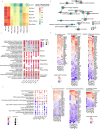This is a preprint.
Hofbauer cells and fetal brain microglia share transcriptional profiles and responses to maternal diet-induced obesity
- PMID: 38187648
- PMCID: PMC10769274
- DOI: 10.1101/2023.12.16.571680
Hofbauer cells and fetal brain microglia share transcriptional profiles and responses to maternal diet-induced obesity
Update in
-
Hofbauer cells and fetal brain microglia share transcriptional profiles and responses to maternal diet-induced obesity.Cell Rep. 2024 Jun 25;43(6):114326. doi: 10.1016/j.celrep.2024.114326. Epub 2024 Jun 8. Cell Rep. 2024. PMID: 38848212 Free PMC article.
Abstract
Maternal immune activation is associated with adverse offspring neurodevelopmental outcomes, many mediated by in utero microglial programming. As microglia remain inaccessible throughout development, identification of noninvasive biomarkers reflecting fetal brain microglial programming could permit screening and intervention. We used lineage tracing to demonstrate the shared ontogeny between fetal brain macrophages (microglia) and fetal placental macrophages (Hofbauer cells) in a mouse model of maternal diet-induced obesity, and single-cell RNA-seq to demonstrate shared transcriptional programs. Comparison with human datasets demonstrated conservation of placental resident macrophage signatures between mice and humans. Single-cell RNA-seq identified common alterations in fetal microglial and Hofbauer cell gene expression induced by maternal obesity, as well as sex differences in these alterations. We propose that Hofbauer cells, which are easily accessible at birth, provide novel insights into fetal brain microglial programs, and may facilitate the early identification of offspring vulnerable to neurodevelopmental disorders in the setting of maternal exposures.
Keywords: Hofbauer cells; Single-cell RNA sequencing; microglia; neuroimmune; obesity; sex differences.
Conflict of interest statement
A.G.E. serves as a consultant for Mirvie, Inc. outside of this work. A.G.E. receives research funding from Merck Pharmaceuticals outside of this work. R.H.P. is a founder and member of the scientific advisory board of Psy Therapeutics; a member of scientific advisory boards for Swan AI Studio, Belle Artificial Intelligence, Genomind, and Circular Genomics; and consults to Alkermes, Burrage Capital, and Vault Health. He serves as an associate editor for JAMA Network Open. All of these roles are outside the present work.
Figures





References
Publication types
Grants and funding
LinkOut - more resources
Full Text Sources
Research Materials
